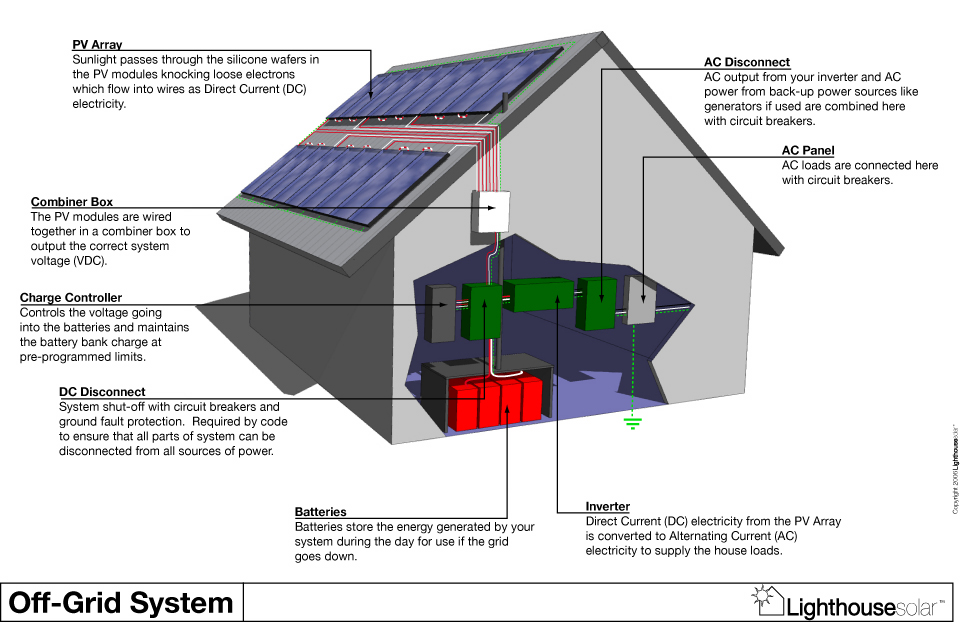Economics
Powered by SolarEnergy.net
To Calculate the economics of a home Solar-Electric System, you need to be aware of the amount of electricity per day you will need, which is expressed in kilowatt hours per day (KWH/day). You can calculate this information from the power needs of the lights and appliances you have in a home or cabin, or, take your monthly electric bill and divide the number of kilowatt hours consumed by the number of days in the month to get the average daily usage for that month. Electricity consumption does vary during the year. It would be best to add up a years worth of electricity used and divide the total hours by 365.
The average cost of a Solar-Electric system is determined NOT by the KWH/day produced by the system, but by the hourly capacity the Solar-Electric System can produce. Most Solar-Electric Systems in the United States have an hourly capacity of approximately 2KW. That means the system will produce 2 KWH for every hour of sunlight it receives. Assuming a minimum of five hours of Sun light, that’s 10 KWH/day or about a third of the electricity needed for the average home.
For most Solar-Electric Systems, pricing works out to be about $4 per watt, or $4000 per kilowatt of capacity. Depending on your system configuration, you may need batteries, controllers, and labor to install the system. These needs add around $5 per kilowatt for an approximate total of $9000 per kilowatt of capacity installed. Note that battery storage for these multi-kilowatt systems would add approximately 50% to the system cost.
Therefore a 2KW Solar-Electric System without batteries would cost about $9000, and a larger 4 KW system would cost around $16000. Now the addition of battery storage will increase the cost to about $18000 for a 2KW Solar-electric System, and the larger 4KW system would cost about $36000.
Next, calculate the approximate cost per kilowatt hour. Multiply the system’s minimum daily output (not its hourly capacity) by 365 to find its yearly output. Then multiply by 25 to find the output over the warranted life of the system. Divide the result into the systems total cost. So a 2KW and a 4KW solar-electric system would cost about 16.5 cents per kilowatt hour. If the system will receive more than 5 hours of sunlight a day, the system could cost around 12 cents per kilowatt.
For businesses, the economics will be especially cost effective when you figure the peak demand usage rates. A solar-electric system produces its maximum capacity during peak usage which would drastically lower energy consumption from your utility company.
Financing & Options
 A 4KW system capitalized over a 15-year second mortgage at 9% interest would cost $263 per month for nearly all the electricity an average home in America would require. A 2KW system capitalized over a 15-year second mortgage at 9% would cost $132 per month for 1/3 to 1/2 of the electricity needed for your home or business.
A 4KW system capitalized over a 15-year second mortgage at 9% interest would cost $263 per month for nearly all the electricity an average home in America would require. A 2KW system capitalized over a 15-year second mortgage at 9% would cost $132 per month for 1/3 to 1/2 of the electricity needed for your home or business.
1st and 2nd mortgages are among the most familiar ways to use the equity in your place to pay for the Solar-Electric system. An increase market value of your property is realized as soon as the system is activated.
Renewable energy financing and home energy loan programs are becoming more popular with state based funding programs such as Keystone HELP.
Energy Associations, such as the EGIA, also provide unique financing for residential and commercial customers intending to install a Solar Electric System.
Local electrical utilities are getting into the Solar Electric systems financing business for commercial and residential systems.
Solar Leasing programs offer a low monthly payment with low out of pocket up front expenses with the option to buy out your lease at the end of the term.
Solar Energy is One of the Easiest and Smartest Ways
to Control the Cost of Doing Business!
By harnessing the power of the Sun, people all over the world produce their own pollution-free reliable electricity. Technological advances, government assistance, the need for reliable power, and the growing urgency to reduce the use of fossil fuels make renewable energy systems increasingly attractive to people around the world.

Solar technology makes it possible for home and business owners to have dependable power from renewable sources. Mass production has significantly reduced the price of solar electric systems and their components. Solar systems with battery- based back-up power can ensure reliable power even when the utility grid is down.
Deregulation has created an atmosphere of change in the United States. We are experiencing higher electricity rates and electricity shortages. Laws usually referred to as net-metering allow solar energy system owners to feed their excess generated electricity back to the utility. The system owner receives a credit or payment for solar-generated electricity fed into the grid. In other words, you pay only for the electricity you consume – the amount of electricity you take from the utility minus the amount you generate and feed back from your solar system. With a solar electric system you can provide yourself with protection from the rising prices of fuel, because your system’s fuel is the Sun.
